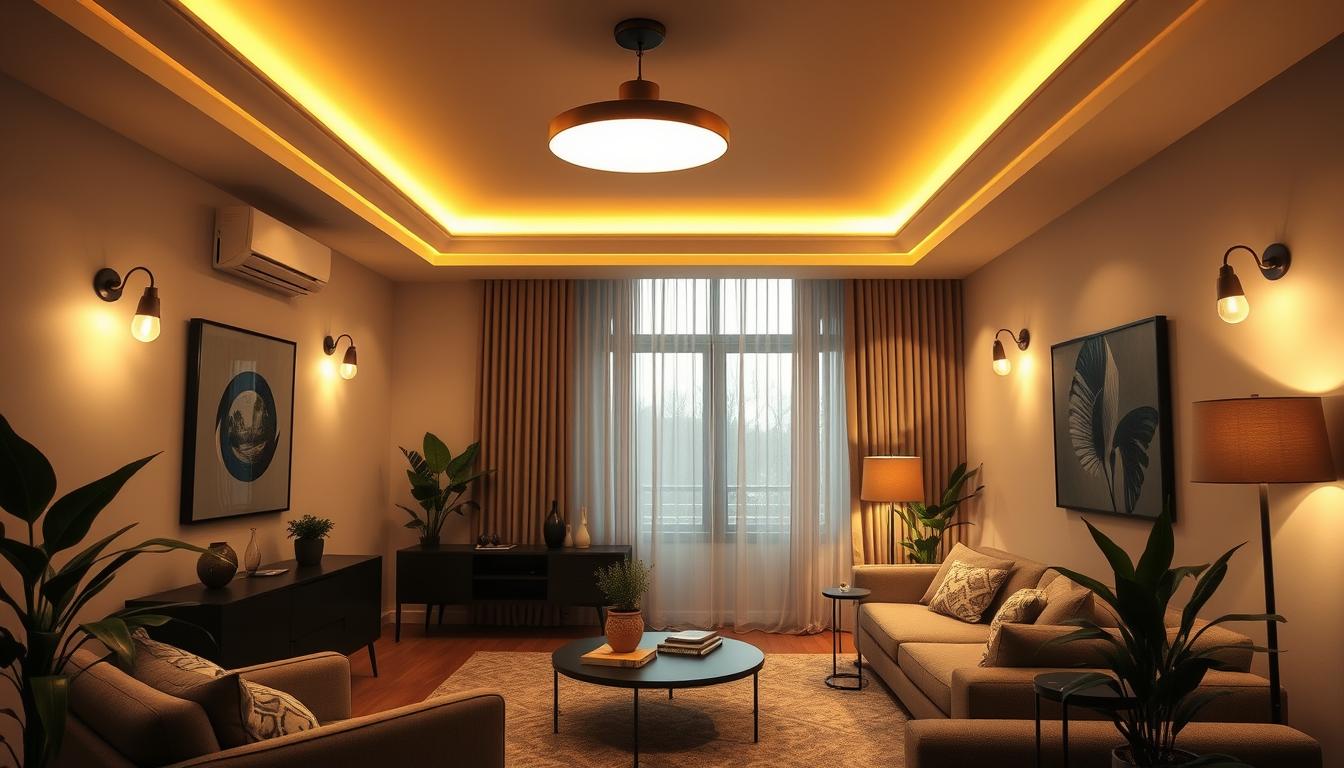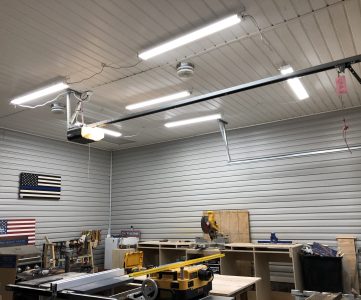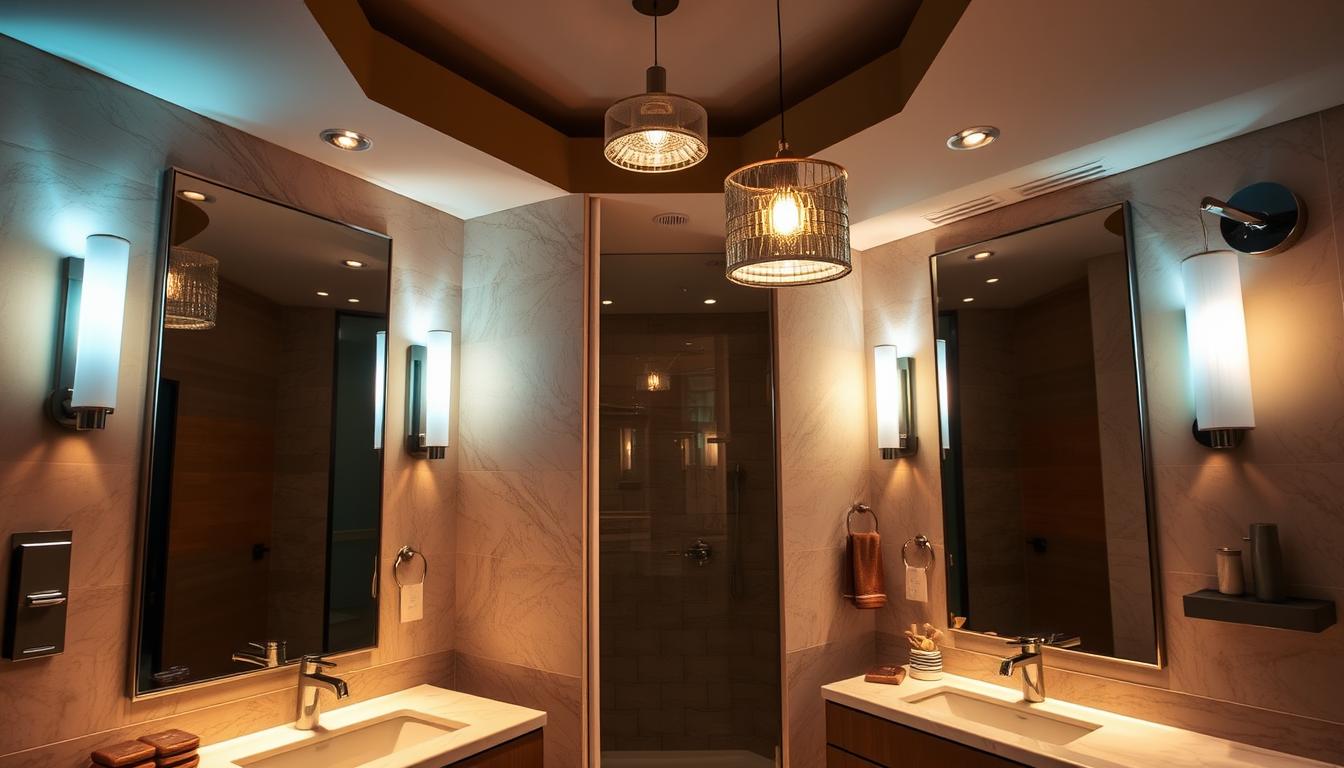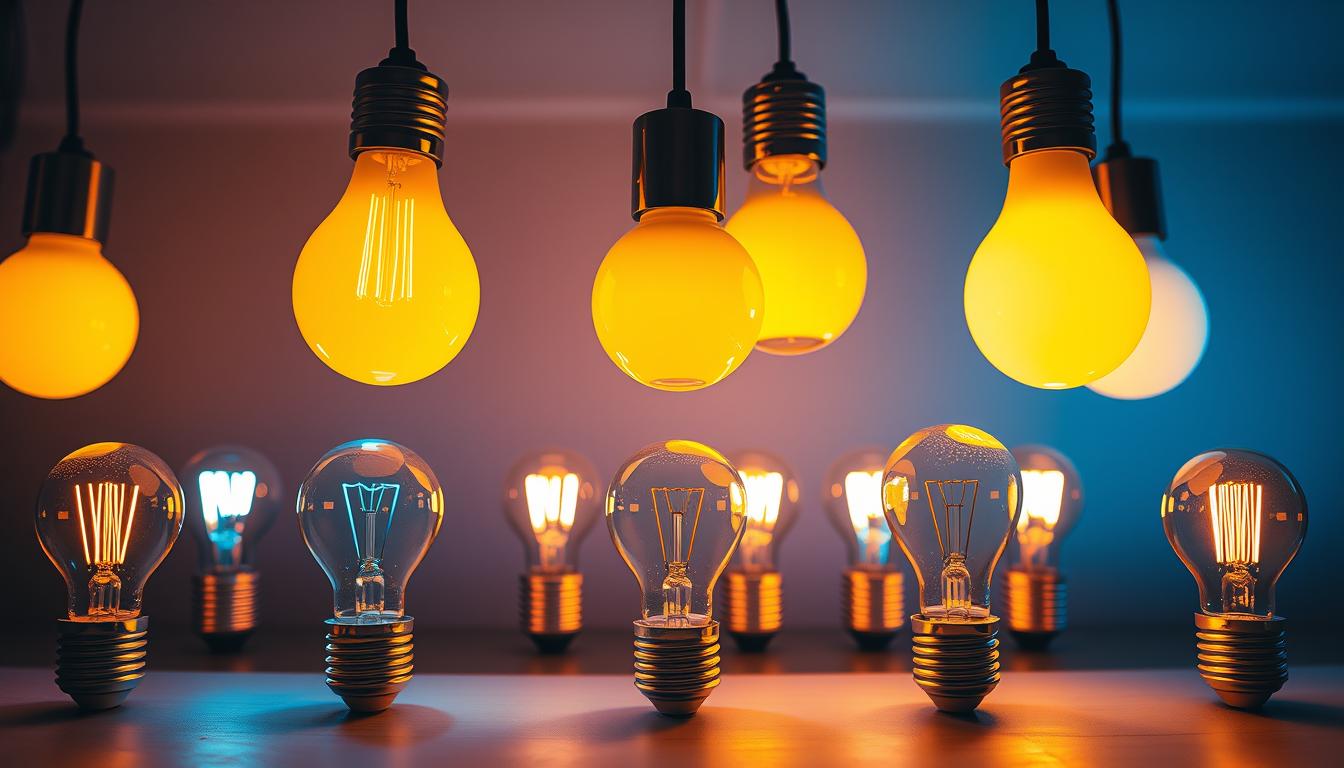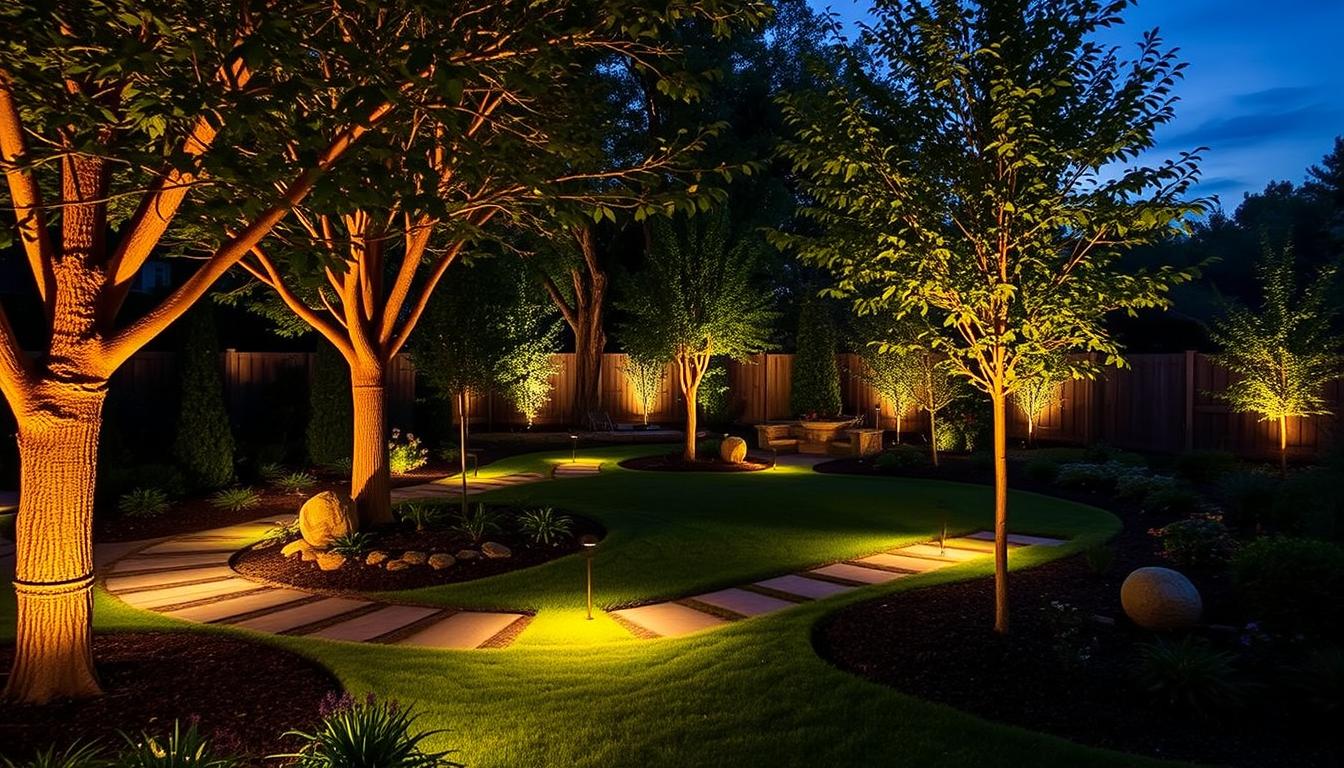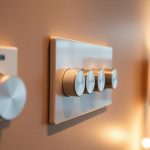Energy-efficient lighting is a smart way to cut down on your utility bills. Using efficient bulbs can greatly reduce your energy use. This not only saves you money but also helps the environment.
With the right lighting, you can make your home stylish and bright without spending a lot. This is a great choice for anyone looking to save money.
Switching to energy-efficient lighting offers many benefits. It cuts down on energy use and lowers your bills. This is a smart move for any homeowner.
With efficient bulbs, you can have both style and energy savings. This creates a beautiful and functional home.
Key Takeaways
- Energy-efficient lighting helps reduce energy consumption and lower utility bills
- Efficient bulbs contribute to significant cost reduction and energy savings
- Energy-efficient lighting solutions can create a stylish and well-lit home
- Reduced energy consumption leads to a more sustainable living space
- Energy-efficient lighting is a smart choice for homeowners looking to save money
Understanding Energy-Efficient Lighting Basics
Energy-efficient lighting is key to saving energy without losing light quality. It uses new tech like LED and CFL bulbs. These bulbs use less energy than old incandescent bulbs.
Energy-efficient lighting also supports green lighting efforts. It cuts down on greenhouse gas emissions. This makes our environment greener and supports green lighting practices.
Types of Energy-Efficient Bulbs
- LED (Light Emitting Diode) bulbs
- CFL (Compact Fluorescent Lamp) bulbs
- Halogen bulbs
These bulbs last longer and use less energy. They also cost less to maintain. Choosing them helps save money and the planet.
How Energy-Efficient Lighting Works
Energy-efficient lighting uses new tech to save energy. It uses special materials and designs. This includes semiconductors in LED bulbs.
| Bulb Type | Energy Efficiency | Lifetime |
|---|---|---|
| LED | High | Up to 50,000 hours |
| CFL | Medium | Up to 10,000 hours |
| Halogen | Low | Up to 2,000 hours |
Knowing how energy-efficient lighting works helps us make better choices. It leads to a greener future.
The Real Cost Benefits of Switching to Efficient Lighting
Switching to energy-efficient lighting can save homeowners a lot of money. This change can cut down on utility bills over time. It’s a smart move for any home.
Here are some key benefits of using energy-efficient lighting:
- It uses up to 80% less energy, saving a lot on bills.
- These lights last longer, saving money on replacements.
- They’re better for the environment, producing less waste and pollution.
Studies show that homes can save up to $100 a year by using these lights. It might not seem like a lot, but it adds up. This change helps save money and is good for the planet.
Maximizing Energy Efficiency in Your Home Lighting
To cut down on power use and boost energy efficiency, focus on each room. Look at what lighting each area needs and pick the best options. For example, using energy-saving bulbs in living spaces can really cut down on waste.
Some ways to save energy include smart lighting systems and automation. These can be set to turn off when not needed. Features like motion sensors and timers help lower bills and use less power.
Room-by-Room Lighting Solutions
- Use efficient bulbs in living areas, such as LEDs or CFLs
- Install motion sensors in hallways and stairways
- Use timers for outdoor lighting to minimize power consumption
Smart Lighting Systems
Smart lighting works with home automation to save energy. You can control it from your phone or tablet. This lets you adjust lights and schedules easily.
| Lighting Solution | Energy Efficiency | Cost Savings |
|---|---|---|
| LED Bulbs | Up to 80% | Up to 50% |
| CFL Bulbs | Up to 70% | Up to 30% |
| Smart Lighting Systems | Up to 90% | Up to 60% |
By using these methods and energy-saving bulbs, you can greatly reduce your energy use and bills. Plus, you’ll help the planet.
Style and Design Considerations for Modern Lighting
When we talk about modern lighting, light quality is key. It changes how a room feels and looks. Now, with a focus on green lighting, we have many energy-saving choices that are also stylish and good for the planet.
Some popular design options include:
- Energy-efficient lighting fixtures that combine style with functionality
- Green lighting solutions that reduce energy consumption and minimize environmental impact
- Innovative lighting designs that incorporate natural materials and unique textures
Choosing the right lighting design makes a home beautiful and green. As light quality keeps changing, it’s important to keep up with new trends and tech for a stylish, eco-friendly home.
In conclusion, modern lighting is more than just working well; it’s about making a space welcoming and unique. By thinking about light quality and green lighting, we can make a home that’s both stylish and sustainable.
| Lighting Option | Energy Efficiency | Style |
|---|---|---|
| LED Bulbs | High | Modern |
| Smart Lighting | High | Contemporary |
| Natural Lighting | Very High | Eco-Friendly |
Choosing the Right Color Temperature and Brightness
Choosing the right color temperature and brightness is key for energy-efficient lighting. It helps create the perfect ambiance while saving energy. Bulbs come in various colors, from warm white to cool blue, each with its own feel.
Understanding Lumens vs. Watts
It’s important to know the difference between lumens and watts. Lumens show how much light a bulb gives off. Watts show how much energy it uses. By picking bulbs with high lumens and low watts, you save energy without losing brightness.
Color Rendering Index (CRI) Explained
The Color Rendering Index (CRI) is also crucial. It shows how well a bulb shows colors, with higher numbers being better. Choosing bulbs with high CRI values makes your space look more vibrant and inviting, while saving energy.
Creating the Perfect Ambiance
To get the perfect ambiance, mix different bulbs. Warm white bulbs are cozy for living rooms. Cool blue bulbs boost productivity in home offices. Try different lighting to find the best mix of energy savings and atmosphere.
| Bulb Type | Color Temperature | Lumens | Watts |
|---|---|---|---|
| Incandescent | 2800K-3000K | 800-1100 | 60-100 |
| Halogen | 2800K-3000K | 800-1100 | 40-70 |
| LED | 2700K-5000K | 800-1100 | 6-12 |
Installation and Maintenance Tips for Long-Term Savings
Proper installation and maintenance of energy-efficient lighting are key for long-term cost reduction and lower utility bills. Homeowners can cut down on energy waste by following simple steps. This ensures their lighting systems work at their best.
Some important installation tips include:
- Hiring a licensed electrician for correct installation
- Using high-quality materials and fixtures
- Following manufacturer instructions for maintenance and replacement
Regular maintenance is also crucial for the longevity of energy-efficient lighting. This includes:
- Checking for dust and dirt buildup
- Replacing faulty or damaged parts
- Monitoring energy use to spot areas for improvement
By following these tips, homeowners can see big savings on cost reduction and utility bills. They also help the environment by using energy more efficiently.
Environmental Impact and Sustainability Benefits
As we explore energy-efficient lighting, we must think about its environmental impact. Choosing green lighting cuts down our power use and supports a greener future. This action not only lessens our carbon footprint but also helps reduce harmful emissions.
Green lighting offers several advantages:
- Less energy use: Green lighting needs much less power than old lighting, cutting down on energy use and carbon emissions.
- Longer life: LED bulbs, for example, last longer than traditional bulbs. This means we need to replace them less often, reducing waste.
- Recyclable materials: Many green lighting products are recyclable. This helps cut down on landfill waste and supports a closed-loop economy.
To lessen our environmental impact, we must recycle and dispose of lighting materials correctly. Here’s how:
Carbon Footprint Reduction
By choosing wisely about our lighting, we can greatly reduce our carbon footprint. This is done by picking energy-saving lights, using less power, and recycling lighting materials.
Disposal and Recycling Guidelines
It’s key to dispose of lighting materials the right way to protect the environment. Always recycle when you can and safely dispose of harmful items like batteries and electronics.
By embracing green lighting and using less power, we pave the way for a greener future. As we move forward with energy-efficient lighting, let’s keep the environment and sustainability in mind. This will ensure a brighter, more sustainable world for everyone.
| Lighting Option | Energy Consumption | Carbon Footprint |
|---|---|---|
| Incandescent Bulbs | High | High |
| LED Bulbs | Low | Low |
| Halogen Bulbs | Medium | Medium |
Common Myths About Energy-Efficient Lighting Debunked
Many people think energy-efficient bulbs are too pricey. But, the upfront cost is worth it for the long-term savings. Using these bulbs can save a lot of energy, making them a smart choice.
Some folks believe these bulbs aren’t as bright as regular ones. But, there are many energy-efficient bulbs that are just as bright. You can find bulbs for any lighting need, from soft glows to bright task lights.
Performance Misconceptions
Some think energy-efficient bulbs don’t work as well as old bulbs. But, LED bulbs, for example, last up to 25 times longer. This means you save money in the long run, even if they cost more upfront.
Cost Analysis Facts
Let’s look at the cost of energy-efficient bulbs:
- Switching to these bulbs can save a household up to $100 a year.
- They last much longer than old bulbs, so you don’t need to replace them as often.
- Using them also helps the environment by using less energy.
Knowing the truth about energy-efficient lighting helps homeowners make better choices. They can enjoy savings and use bulbs that are good for the planet.
Conclusion: Embracing Smart Lighting Choices for a Brighter Future
Switching to energy-efficient lighting can really cut down your cost reduction and utility bills. LED, CFL, and other smart lights offer long-term energy efficiency and big savings. They also help the planet by lowering your carbon footprint.
Choosing energy-efficient lighting is a smart move for your home or business. It’s easy to make a big difference. Whether updating or starting fresh, there are many stylish and efficient options. The right lights can make your space bright, beautiful, and affordable, leading to a greener future.
